Average Birding

An Osprey Spectacular
It's time to go to Scotland, and I am very excited.
The plan is to drive from Inverness up to the North Coast, then down the West coast, overnighting at various campsites. Depending on how long that takes, we'll improvise with whatever time we have left.
Pronoun guidance: AB1 is excited. This post covers the events of June 29-30th , 2018. AB2 is excited too, to be clear.
More plan details.
Camping is a bold plan. AB2 and I have camped before, but only for a night or two; this holiday is going to involve up to eight nights in a row. How we'll cope with this is anyone's guess; a test erection of the tent in the back garden only generated one mild argument (over how to put the tent away without getting the dry bits wet), so I'm unusually optimistic.
We spend the first night in a modest B&B near the airport - we arrive too late to get much further, and even the drive to this place is borderline entertaining, along considerably tight roads in pitch darkness.
Stage 1: Inverness to Fairy Glen
The next morning we are up and about...reasonably early - we've got a pre-booked shop to pick up from Tesco, and, it turns out, some additional camping-related items to pick up from a local Go Outdoors. From there, we finally make a start, driving North out of Inverness on the A9. As we cross the Beauly Firth, I start to relax. The year outside birding's been taking its toll; it's a marvellous sensation to feel some of the layers of stress shedding away, and being replaced by excitement.
We've been to the Black Isle before - so we skip the Black Isle Brewery tour (worth a visit if you're in the area, the heather honey one is very nice) and Canonry Point (cold, windy, impossible to park, no sign of promised cetaceans) and head instead to RSPB Fairy Glen. Gordon (the author of the book) tells us this is a great place for a Dipper. Yes, we have Dipper already, but one should never turn down an opportunity to see another. We also have no idea how good Gordon's advice is going to be; this is an ideal test.
We trot off up the path; we've gone barely 100m before a Dipper pops up for us. Excellent. Ten points to the book. Bonus - the popularity of this walk means it is accustomed to people, and doesn't immediately fly off upstream, as Dippers are wont. We spend an inordinate amount of time taking what turn out to be fairly average photos (the light wasn't tremendous, in our defence) before deciding that making further progress North is more important to us than the remainder of the walk up to the falls.

A terrifying car ferry
Did we mention the weather? It is spectacular. As a result, the views over the firth from the remaining route to Cromarty are phenomenal. From Cromarty we're going to get the ferry over to Nigg.
This is somewhere between entertaining and terrifying. Before the ferry even arrives I've got myself into a state; having parked the car I realise there are enough road markings to tell me I am in completely the wrong place. Escaping it will require something akin to reverse parking; my least favourite manoeuvre, particularly in a car I don't know, and this car, in addition, has one of those useless proximity sensors that goes into heart-attack-fetch-the-defibrillator mode when the sensor is briefly washed over by an imaginary breeze.
The ferry turns up. It carries two cars, if you can park them within about 1mm of each other. Getting on to the ferry is no great drama; we're well directed by the steward. I put the handbrake on with great glee, exit the car and enjoy the ride across, safely separated from the more social side of the boat by the two cars on board. I'm in denial about what's going to have to happen at the other end; I am inventing mechanisms by which the boat will magically flip around on mooring so I can drive off the same way I drove on, i.e in first gear, rather than reverse.
No such luck. Worse, we have to watch some stereotypically efficient Germans easily manhandle their giant SUV off first. In the end, it isn't as tricky as I'd feared - one only needs to reverse straight off, and do it slowly to let the weight of the boat keep the ramp reasonably steady. Barring one non-actionable piece of advice from the co-driver, we make it off the ferry alive, and make quick work of the short drive to RSPB Nigg Bay.
RSPB Nigg Bay
This is a marvellously simple reserve; a small car park, 150m of path to a hide. Excellent interpretive panels. Before we get to that though, lunch. Cold Spanish omelette in burning hot sunshine. Perfect. Two or three Yellowhammer serenade us while we eat. The beginning of a long search for Whinchat begins - I could easily imagine one in the foliage on the other side of the road, or on the telephone wires. No joy though.
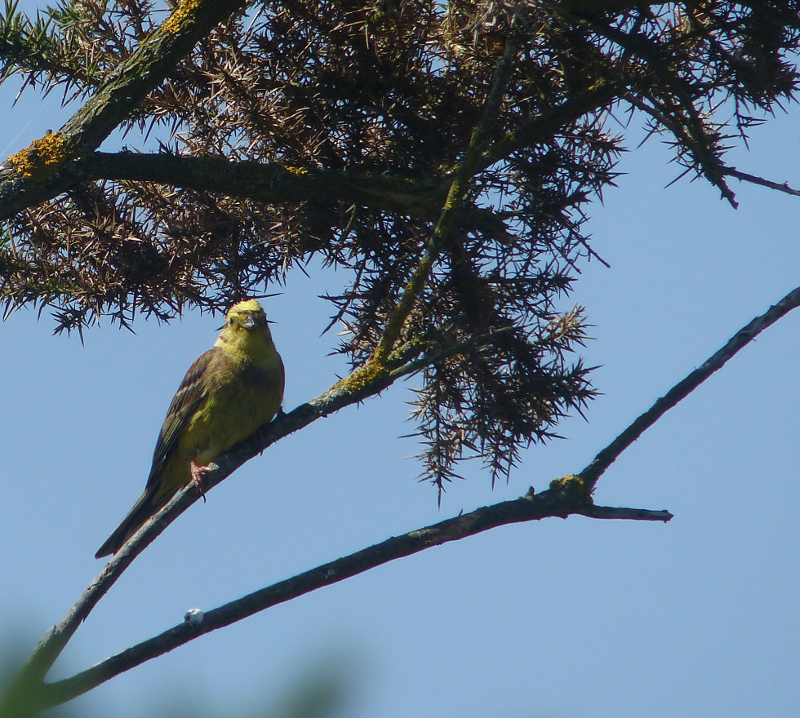
Ok, yes, we cheated, last post's Yellowhammer image was actually from here , sorry.
Once we've finished our car-based feast, we trundle down the track to the hide, accompanied by Linnets and Reed Buntings. The hide is glass walled, and, as a result, stiflingly hot. No-one has told this part of Scotland that the weather is supposed to be terrible all the time.
The view from the hide is marred by another side effect of the weather - anywhere with significant land between us and the water has a seething heat haze on it. The bunch of waders on the far shore are rendered unidentifiable. I'd guess mostly Curlew and Redshank based on size, but they could all be Long-billed Dowitcher for what we can see. Giving up on birds on the ground, I look up. Gordon claims we should see Osprey here, and, unlike Dipper, that would be a tick.
There is a bird of prey flopping about at the end of the channel that runs on the landward side of the sea wall. In the moments where it's above the heat haze, but below the horizon, its lighter parts indicate it is an Osprey. This is borderline unbelievable. Other site guides we've read offer almost guaranteed disappointment; Gordon, so far, is two for two.
Loch Fleet
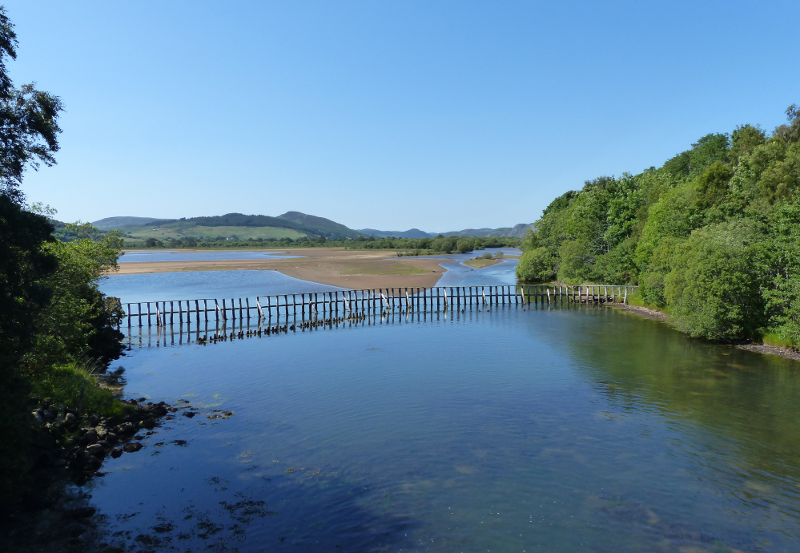
Back to the A9. Another gorgeous crossing follows, this time across the Dornoch Firth. Our next stop is another bridge; or maybe it's more of a causeway. Yes, we're at Loch Fleet. There's only a limited amount of exploring to do here, but we make a good go of it. First, we poddle across the smaller bridge, where Swallows are zipping around it and Siskins are mobbing some well-tended birdfeeders in a garden across the way.
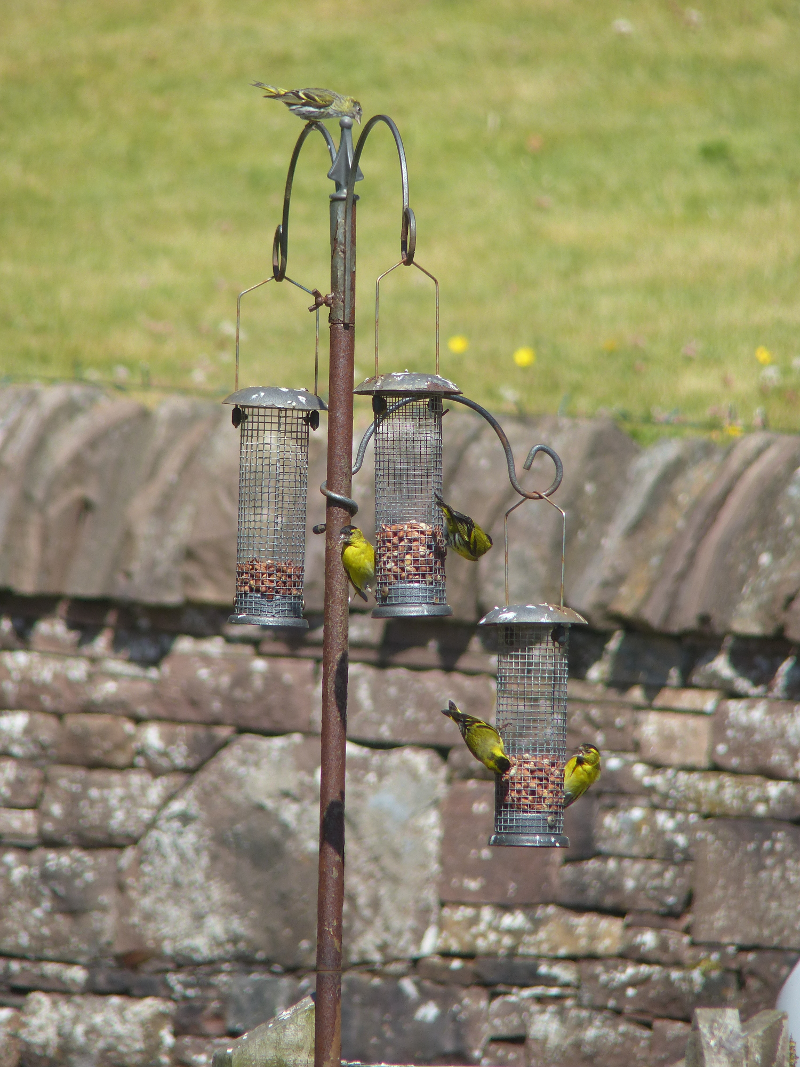
Returning to the original side, we get the scope on the contents of the muddier side of the Loch, which is festooned with Curlews. We spend a lot of time getting very excited by a completely unidentifiable bird sitting on the mud, until it stands up and reveals it is a juvenile Black-headed Gull with most of its face covered in blood. Nice.
Just as we're rolling out of the car park, three birds of prey float in. Oh balls. Those are Ospreys! The car is unceremoniously ditched, optics are fetched out again and a less heat haze mangled view of Osprey is duly had. Wow.
The next stop isn't much further as the crow flies - the car park to access it, is, however - we drive all the way Golspie only to do a 300 degree turn back towards Littleferry. Believe it or not, we're still on the same nature reserve. This side is considerably more wooded. Gordon claims Redstart and Crossbill are possibilities here, as well as yet more Ospreys. A beautiful walk through the woods yields, amusingly, two more of the third only; and these Ospreys we hear as well as see. Woodland birds are a bit thin on the ground; a small band of Long-tailed Tits and some very proud Chaffinches.
Making camp in Lairg
That's enough Loch Fleet - we're starting to get into late afternoon, and we promised ourselves that we'd get to the campsite and pitch in time for some dinner. We head back towards the Mound end of the reserve, but this time, turn North West along the A839 towards Lairg.
This is an unbelievably scenic road; it follows the River Fleet's valley back up into the the hills until it disappears under a forest. It also appears to be home to a double digit percentage of the UK's Pied Wagtails. They are all over the place!
Our first campsite is just North of Lairg, Pondside Camping. AB2 ferrets out someone from reception to pay, we drive into what we guess is an area we can pitch and get the tent up. Excellent work, all round.
We realise that, given it's 6pm, we have another four to five hours of daylight. That's more than enough time for another solid bit of exploring, so we set out towards the Falls of Shin. According to all of our sources, there should be: a) a waterfall; b) salmon jumping up it; and, c) a nice woodland walk.
The Falls of Shin
The capitalisation, it turns out, was warranted. We were expecting a car park and a (probably already closed) cafe, but everything is shiny and new, there's a visitor centre worthy of the name and a restaurant attached to it that almost manages to tear us away from the picnic we've got ready in the car. This is the sort of place I can imagine a coach tour turning up; I'm suddenly very glad we aren't in the school holiday period.

We decide to explore the falls to check the veracity of the salmon claim. We are sceptical; fish jumping, we suspect, only occurs when Grizzly Bears and a BBC wildlife camera team are present. To our great surprise, salmon are demonstrably (if intermittently) trying to jump up the falls; we see one within the first couple of minutes. It's quite something!
The fish are not small - a good couple of feet long, I'd guess, and they often stay airborne for a good second or so, thrashing at the air ineffectively. AB2 makes some excited "wheeee" noises. We guess that under the surface, more success is had - each fish we see go airborne seems to go backwards. We spend a good fifteen minutes failing to photograph this event before deciding we really need to eat some food.
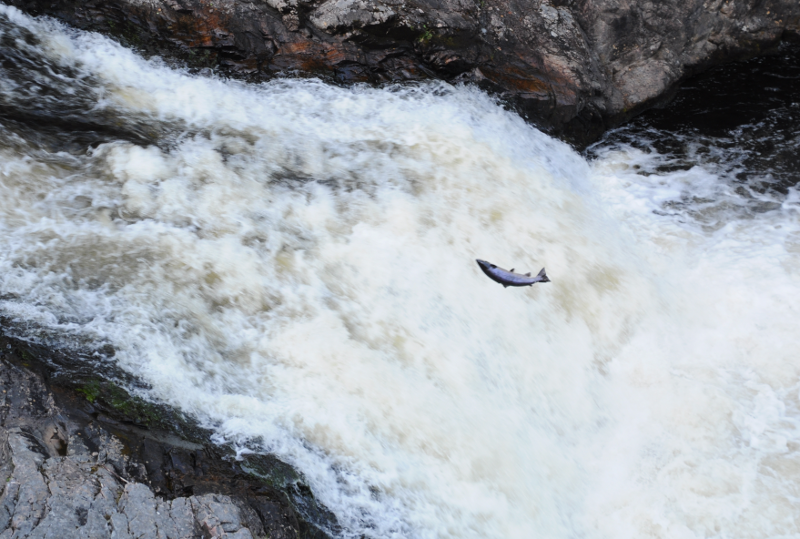
Back up the ramps to the car park, there is a well-tended picnic area for this very purpose. After a quick lie down in the sun (I've been driving all day, and I'm still not totally relaxed; I've found that being connected to the ground in as many places as possible helps), we examine the interpretive panels in hope of figuring out a suitable circular walk.
It turns out there are several - we pick the intermediate one, which should take us somewhere in the region of forty minutes. We've gone all of five before we're surrounded by bird song. Bird song that falls into the "interesting" bucket: definitely not the usual suspects. Annoyingly, this coincides with standing on an area of path that is being swarmed by flies. Perhaps this explains what the first noise is: a family of Spotted Flycatchers (a later check on xeno-canto tells us what we were hearing was the begging call of the juveniles). The parents are flycatching between three or four of what we guess are their favourite perches.

We perform a strange dance of looking at the birds, sprinting 10m while flailing our arms at the flies, stopping for another look and then returning to the first point in the same fashion. This either goes unnoticed by the flycatchers, or they find it amusing enough to not be too bothered by it, because this technique yields some lovely views, and to our later surprise, some not totally awful photos.
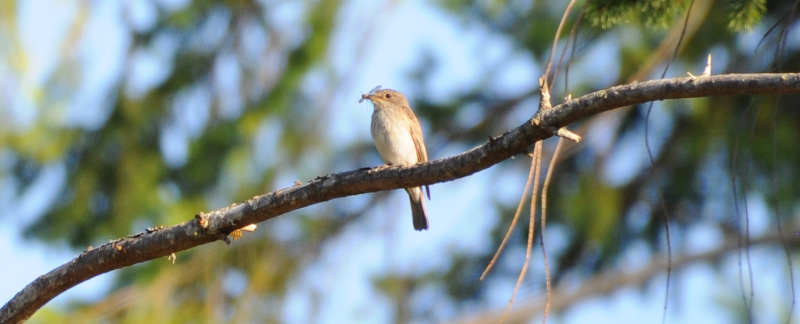
As we move onwards, the second unidentifiable noise gets louder, and then gets resolved - this time we've got a family of Willow Warblers. They're hopping about in the lower shrubs; making steady progress - they cross the path and then, without seeming to go too quickly, are out of sight and earshot in under a minute.
On their own, these encounters would be enough to make this a worthwhile walk, but we soon realize that these two species are the two standard birds for this piece of woodland (or, at least, they are on a summer evening); we see several more groups of both as we go. If we were counting, we'd have lost count of both species by now.
As the path heads uphill, the wood thins and becomes more heath-like; the path traces the border between the two. A few scattered chats do their usual perching routine, they are all Stonechat though. On the wood side, something that is neither flycatcher nor warbler is sitting on a branch. It looks a bit like a Meadow Pipit. I get excited; a Meadow Pipit sitting in a tree is probably a Tree Pipit. After checking the bird book, the more diagnostic differences (thicker beak, finer streaking on flanks, etc) are also present.

For a woodland walk to yield such density of birds is quite unusual. Most woodland birding, in our experience, verges from 'mostly bird free, with occasional flocks of the usual suspects' to 'dour, walk through ostensible dark (and possibly dead) forest'. This walk has been neither of those; what a delight.
Raven's Rock Gorge
Back to the car. Hours of daylight remaining: two. Jeez. How do people cope with all of this time? We consult with Gordon. Apparently one of the UK's highest rated woodland walks is a short drive away (Raven's Rock Gorge), and, as a bonus, it has a giant sculpture of a bear at the end of it. We might also hear Long-eared Owl there. Worth a go!
In the end, the walk ends up rather shorter than we expected - fifteen minutes either way - and, wildlife wise, it is somewhat underwhelming, with Grey Heron the only bird of note. Perhaps we're just a bit late, or a bit tired, or we went the wrong way.
The drive there was lovely, mind - spectacular views along the Kyle of Sutherland. Oh, and the bear sculpture provided some small entertainment. We probably don't wait until late enough to hear the owl - at some point AB2 and I wordlessly agreed it would be nice to get back to the campsite soon, i .e before it gets dark.
Back to the campsite
We get back to the campsite for just before 10pm. There's still plenty of light. There are also plenty of midges. The 'Pondside' should probably have warned us of that. I can hear a Grasshopper Warbler reeling somewhere in the field on the other side of the pond. Time for one last tick? It's worth a go.
Finding this little brown job turns out to be much harder than I'd hoped. The open landscape makes the sound not that useful in getting a fix on the bird. We do a lot of wandering around with our hands cupped behind our ears; all this does is convince us the bird is further away than we thought.
As this field rolls away from the campsite, it gets progressively damper, ending up in a tiny burn. As it dampens, the foliage gets deeper - a mixture of longer grasses and small shrubs. If the bird is below the grass layer this is hopeless; so we just need to scan the things sticking up from it. A first look at these yields no fruit. AB2 decides that the midges/bird ratio has dropped below critical and heads back to the tent ("I have faith in you" she says, cryptically, on her way off). I hang about a bit. The reeling stops. I start to follow AB2's footsteps, and after a few seconds it restarts. Oh, we're playing that game are we? Well. Well then.
I decide the bird is, once again, further away than originally thought. I move further along the field, where an area of the drier grassland juts out into the denser stuff. The reeling continues, seemingly still right in front of me. Another scan of the bushes and shrubs yields nothing. The reeling stops. I start heading back to the tent again, to see if that has the same effect. The reeling begins again. Back we go.
This time I try varying where I stand between multiple scans of the various plants sticking out of the long grass. There's the little brown beast; barely a couple of inches above the vegetation line, on a tiny offshoot of what looks like a thistly tree (botany isn't my strong point, sorry). It won't stop reeling now, with its mouth wide open the whole time, giving the impression that the whole bird is vibrating. Perhaps it is; the percussive nature of sound and Newton's 3rd Law suggests it might be.
I return triumphantly to the tent and collapse into one of the best sleeps I've had for ages. Fourteen hours outdoors. Six Ospreys. Four year ticks. What a day!